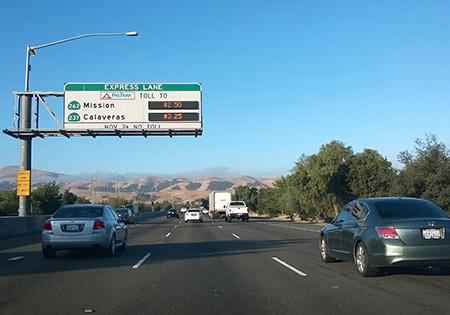Congestion Control Experience and Recommendations Roundtable

This Roundtable reviews a wide range of congestion control measures, analysing their effectiveness, financial and operational requirements, implementation time and public acceptability. A strong focus is on the role of technology in addressing congestion, including sensors, wireless systems, traffic light optimisation and trip planning data. The Roundtable explores in depth the use of High-Occupancy Toll (HOT) lanes to control congestion, the different ways in which they can be used and their effectiveness relative to other initiatives.
For further information regarding participation in the Roundtable, please contact Rex Deighton-Smith
Videos
Papers and presentations
Papers and presentations
The Impact of U.S. HOV and HOT Lanes on Congestion
![]() View Presentation, slides, speech (PDF) (336.03 KB)
View Presentation, slides, speech (PDF) (336.03 KB)
Presentation, slides, speech, 23 September 2020
Robert Poole Director of Transportation Policy, Reason Foundation
The Impact of HOV and HOT Lanes on Congestion in the United States
![]() View Discussion Paper (PDF) (2.72 MB)
View Discussion Paper (PDF) (2.72 MB)
Discussion Paper, 21 September 2020
Robert Poole Reason Foundation, Los Angeles
This paper describes the evolution of high-occupancy vehicle lanes (HOV) and high-occupancy toll lanes (HOT) lanes in the United States. It evaluates their performance and analyses the impact on carpooling and public transport. The demographics of HOV and HOT lane users and the implications for equal access are also examined. The paper also proposes ways to apply lessons learned from the success of HOV and HOT lanes to the political challenges of road pricing.
Congestion Pricing with Minimal Public Opposition
![]() View Discussion Paper (PDF) (1.94 MB)
View Discussion Paper (PDF) (1.94 MB)
Discussion Paper, 21 September 2020
Galit Cohen-Blankshtain
The Hebrew University, Jerusalem
Hillel Bar-Gera
Ben Gurion University of the Negen, Beer-Sheva
Yoram Shiftan
Technion, Israel Institute of Technology, Haifa
This paper reports on the Israeli experience with a high-occupancy toll (HOT) lane between Jerusalem and Tel Aviv. It highlights the integration of a park-and-ride service with the HOT lane and the provision of free parking to encourage carpooling. The paper also analyses Israel’s pilot “Going Green” programme and how it demonstrates the potential of positive incentives to address congestion.
Congestion Control in Singapore
![]() View Presentation, slides, speech (PDF) (1.36 MB)
View Presentation, slides, speech (PDF) (1.36 MB)
Presentation, slides, speech, 23 September 2020
Walter Theseira Singapore University of Social Sciences
Congestion Control in Singapore
![]() View Discussion Paper (PDF) (2.7 MB)
View Discussion Paper (PDF) (2.7 MB)
Discussion Paper, 12 October 2020
Walter Theseira Singapore University of Social Sciences
This paper reviews the development and implementation of congestion control policies in Singapore since the introduction of the Area Licensing Scheme in 1975. It examines the city state’s experience of vehicle quotas, cordon charging and electronic road pricing. It also looks at developments in public transport and urban planning to improve accessibility and congestion control. Both public attitudes to congestion policies and their economic effects are discussed and analysed.
Congestion in Latin American Cities
![]() View Presentation, slides, speech (PDF) (2.2 MB)
View Presentation, slides, speech (PDF) (2.2 MB)
Presentation, slides, speech, 23 September 2020
Juan Pablo Bocarejo Associate Professor, Department of Civil Engineering Universidad de Los Andes, Colombia
Congestion in Latin American Cities
![]() View Discussion Paper (PDF) (2.62 MB)
View Discussion Paper (PDF) (2.62 MB)
Discussion Paper, 21 September 2020
Juan Pablo Bocarejo Universidad de Los Andes, Bogotá
This paper surveys trends in private vehicle use in Latin American cities and related government policies. It discusses the Colombian government’s initiatives to adopt congestion charging in major cities, highlights the political constraints encountered, and discusses policy changes adopted in response. The paper presents modelling results for the impact of different congestion charging proposals and identifies the principal challenges for adopting them.
HOT Lanes: Their Distributional Impact and Effect on Congestion
![]() View Presentation, slides, speech (PDF) (216.95 KB)
View Presentation, slides, speech (PDF) (216.95 KB)
Presentation, slides, speech, 21 September 2020
Jonathan Hall University of Toronto
High-occupancy Toll Lanes
![]() View Discussion Paper (PDF) (1.71 MB)
View Discussion Paper (PDF) (1.71 MB)
Discussion Paper, 21 September 2020
Jonathan Hall University of Toronto
This paper reports the theoretical and empirical evidence on the distributional effects of Express Lanes. It also provides evidence of how they affect congestion, both in the Express Lanes themselves and in the parallel general-purpose lanes. The paper also helps put Express Lanes in context by discussing the merits of alternative approaches to managing congestion such as ramp metering, permits, and vehicle-kilometres travelled charges.